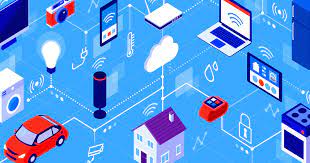The field of IoT (Internet of Things) is continuously evolving, and several future trends and emerging technologies are shaping its development. Here are some notable trends and technologies in IoT data analytics and visualization:
- Edge Computing and Edge Analytics:
Edge computing brings computing resources closer to IoT devices, enabling real-time data processing and analytics at the edge of the network. This trend reduces latency, conserves bandwidth, and enhances data privacy. Edge analytics involves running analytics algorithms directly on IoT devices or edge servers, allowing for immediate insights and faster decision-making. - 5G and LPWAN Connectivity:
The rollout of 5G networks and Low-Power Wide-Area Network (LPWAN) technologies like NB-IoT and LoRaWAN will revolutionize IoT connectivity. 5G offers high bandwidth, low latency, and massive device connectivity, enabling more data-intensive applications. LPWAN technologies provide long-range, low-power connectivity suitable for low-cost and battery-operated IoT devices. - AI-Driven IoT Analytics:
The integration of AI (Artificial Intelligence) and machine learning techniques into IoT analytics is a growing trend. AI algorithms can analyze massive amounts of IoT data, uncover patterns, and generate predictive insights. This enables more accurate and automated decision-making, advanced anomaly detection, and improved optimization in IoT systems. - Digital Twins:
Digital twins are virtual representations of physical devices, systems, or processes. They provide a real-time, digital replica of the physical world, allowing for continuous monitoring, simulation, and analysis. Digital twins enable better understanding, prediction, and optimization of IoT systems, leading to improved efficiency, maintenance, and decision-making. - Blockchain for IoT Security and Trust:
Blockchain technology brings enhanced security and trust to IoT systems. By providing decentralized, tamper-proof data storage and verification, blockchain can protect IoT data integrity, enable secure device identity, and support trusted transactions. Blockchain-based solutions in IoT can enhance security, privacy, and transparency in data analytics and visualization. - Augmented Reality (AR) and Virtual Reality (VR):
AR and VR technologies are finding applications in IoT data visualization. By overlaying virtual information onto the physical world or creating immersive virtual environments, AR and VR can enhance the visualization and understanding of IoT data. These technologies enable interactive exploration, training, and simulation in IoT applications. - Edge AI and Tiny Machine Learning:
Edge AI refers to deploying AI algorithms directly on IoT devices or edge servers, enabling local data processing and decision-making. Tiny machine learning focuses on developing lightweight ML models that can run on resource-constrained IoT devices. These approaches minimize the need for extensive data transmission to the cloud, reduce latency, and enhance privacy in IoT analytics. - Edge Computing Expansion: Edge computing will continue to grow as more IoT devices generate vast amounts of data. By performing data processing and analysis closer to the data source, edge computing reduces latency, enhances security, and enables real-time decision-making.
- Blockchain Technology: Blockchain technology can enhance trust, security, and interoperability in IoT ecosystems. It provides a decentralized and immutable ledger that records transactions between IoT devices, ensuring data integrity, authentication, and secure interactions.
- Data Collaboration and Federated Learning:
Data collaboration and federated learning techniques address the challenge of data privacy and ownership in IoT. Federated learning enables multiple IoT devices to collaboratively train ML models without sharing raw data. This approach preserves data privacy while allowing devices to collectively improve their analytics capabilities. - Smart Cities: Smart city initiatives will continue to grow, leveraging IoT technology for efficient resource management, traffic optimization, waste management, public safety, and enhanced quality of life for citizens.
- Industrial Internet of Things (IIoT): IIoT will drive digitalization and automation in industries such as manufacturing, logistics, and energy. It enables real-time monitoring, predictive maintenance, supply chain optimization, and overall operational efficiency.
- Energy Efficiency Solutions: IoT-driven energy management systems will play a crucial role in optimizing energy consumption, reducing waste, and enabling users to make informed decisions on energy usage.
- Wearable Technology: Wearable devices, such as fitness trackers and smartwatches, will continue to evolve. They will incorporate more sensors and advanced AI capabilities for personalized health monitoring, remote patient monitoring, and preventive healthcare.
These trends and emerging technologies present exciting opportunities for IoT data analytics and visualization. They enable more intelligent, secure, and efficient IoT systems, leading to improved decision-making, operational efficiency, and user experiences in various domains such as smart cities, healthcare, manufacturing, and agriculture.
SHARE
